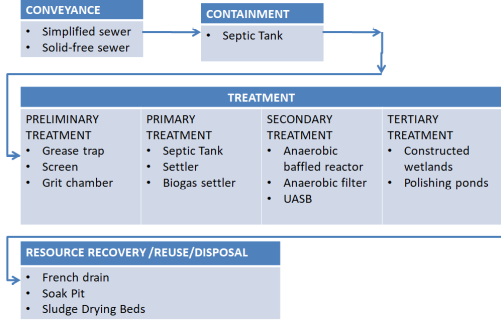Difference between revisions of "Chapter Four: Off-Site Sanitation Systems"
| Line 2: | Line 2: | ||
Off-site sanitation refers to a sanitation system in which wastewater and excreta are collected and conveyed away from the plot where they are generated. An off-site sanitation system relies on a sewer technology (simplified sewer, solid free sewer or conventional sewer) for conveyance of excreta. | Off-site sanitation refers to a sanitation system in which wastewater and excreta are collected and conveyed away from the plot where they are generated. An off-site sanitation system relies on a sewer technology (simplified sewer, solid free sewer or conventional sewer) for conveyance of excreta. | ||
| − | == | + | ==Decentralized Wastewater Treatment Systems (DEWATS)== |
Decentralized wastewater management systems (DEWATS) include all parts of a onsite-sanitation system. In comparison to centralized systems, these systems are located at or near the point of wastewater generation. DEWATS can be characterized and differentiated from centralized systems along the following lines. | Decentralized wastewater management systems (DEWATS) include all parts of a onsite-sanitation system. In comparison to centralized systems, these systems are located at or near the point of wastewater generation. DEWATS can be characterized and differentiated from centralized systems along the following lines. | ||
* Volume: Decentralized systems treat relatively small volumes of water (typically 1-1,000 m³/day), | * Volume: Decentralized systems treat relatively small volumes of water (typically 1-1,000 m³/day), | ||
* Sewer type: Centralized systems typically use conventional gravity sewers, while decentralized systems typically use small-diameter gravity sewers, often employing intermediate settlers for solid-free sewers. | * Sewer type: Centralized systems typically use conventional gravity sewers, while decentralized systems typically use small-diameter gravity sewers, often employing intermediate settlers for solid-free sewers. | ||
| − | == | + | ==Components of DEWATS== |
| − | The components of DEWATS are presented in the schematic layout shown in Figure 4.1 | + | The components of DEWATS are presented in the schematic layout shown in Figure 4.1<br> |
| − | <br> | ||
| − | [[File: | + | [[File:Treatment_Flow_Sheet_for_Components_of_DEWATS.png|600px|link=Chapter_Four:_Off-Site_Sanitation_Systems]]<br> |
| + | |||
| + | Figure 4.27: Treatment Flow Sheet for Components of DEWATS | ||
| + | (Source: MoW, 2018) | ||
| + | ===Containment=== | ||
| + | Containment technologies collect and store wastewater at the user interface on-site. Containment technologies are usually applicable for low-cost, non-sewered sanitation (FS) systems as intermediate storage, but can also serve as pre-treatment modules for small-scale wastewater treatment systems. The main containment technology applicable for wastewater treatment technologies is a septic tank (see Figure 4 .28). | ||
Revision as of 12:52, 14 July 2022
Contents
1 Chapter Four: Off-site Sanitation Systems
Off-site sanitation refers to a sanitation system in which wastewater and excreta are collected and conveyed away from the plot where they are generated. An off-site sanitation system relies on a sewer technology (simplified sewer, solid free sewer or conventional sewer) for conveyance of excreta.
1.1 Decentralized Wastewater Treatment Systems (DEWATS)
Decentralized wastewater management systems (DEWATS) include all parts of a onsite-sanitation system. In comparison to centralized systems, these systems are located at or near the point of wastewater generation. DEWATS can be characterized and differentiated from centralized systems along the following lines.
- Volume: Decentralized systems treat relatively small volumes of water (typically 1-1,000 m³/day),
- Sewer type: Centralized systems typically use conventional gravity sewers, while decentralized systems typically use small-diameter gravity sewers, often employing intermediate settlers for solid-free sewers.
1.2 Components of DEWATS
The components of DEWATS are presented in the schematic layout shown in Figure 4.1
Figure 4.27: Treatment Flow Sheet for Components of DEWATS (Source: MoW, 2018)
1.2.1 Containment
Containment technologies collect and store wastewater at the user interface on-site. Containment technologies are usually applicable for low-cost, non-sewered sanitation (FS) systems as intermediate storage, but can also serve as pre-treatment modules for small-scale wastewater treatment systems. The main containment technology applicable for wastewater treatment technologies is a septic tank (see Figure 4 .28).
